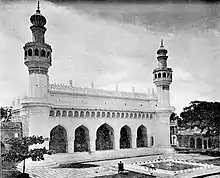Musheerabad Mosque
The Musheerabad MasjidOr MASJID E KALAN, (also known as Musheerabad Badi Masjid, or Jama Masjid Musheerabad) is a mosque located in the Musheerabad locality of Hyderabad, India.[1][2][3] The original portion was constructed in 1560 AD by Ibrahim Quli Qutb Shah,[4] the fourth Sultan of the Qutb Shahi dynasty and is identical to the Hayat Bakshi Mosque located in Hayathnagar area of Hyderabad.
| Musheerabad Mosque | |
|---|---|
 Musheerabad Mosque, photographed by Ghulam Yazdani, c. 1940s. | |
| Religion | |
| Affiliation | Islam |
| Location | |
| Location | Hyderabad, Telangana |
| Architecture | |
| Groundbreaking | 1580 CE |
| Completed | 1611 CE |
| Minaret(s) | 2 |
History
After the fall of Golconda, the mosque went into disuse and remained abandoned till the area became a jagir of Nawab Arastu Jah, the Prime Minister during the reign of Nizam Ali Khan. It was also repaired in 1951. Today, the old structure is in a dilapidated state.
A new four-storied portion has been constructed to accommodate the namazis. There used to be a large courtyard where the new portion stands today.[5]
Architecture
The mosque has five lofty arches and two minarets at the corners.
See also
References
- Iyer, Lalita (3 June 2018). "Hyderabad: The grandeur of Qutb mosque". Deccan Chronicle. Retrieved 20 July 2018.
- "Jamia Masjid Musheerabad, Musheerabad Mosque Hyderabad – Temples In India Information". templesinindiainfo.com. Retrieved 20 July 2018.
- Nanisetti, Serish (19 August 2017). "There lies a forgotten story". The Hindu. ISSN 0971-751X. Retrieved 20 July 2018.
- "District Census Handbook, Series 2, Andhra Pradesh, Hyderabad". Government of Andhra Pradesh. 1987: 13. Retrieved 26 May 2022.
{{cite journal}}: Cite journal requires|journal=(help) - Bilgrami, Syed Ali Asgar (1992). Landmarks of the Deccan: A Comprehensive Guide to the Archaeological Remains of the City and Suburbs of Hyderabad. Asian Educational Services. ISBN 9788120605435.